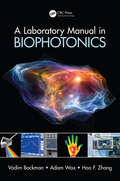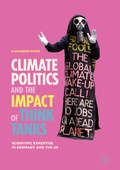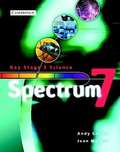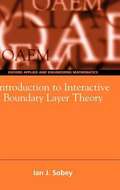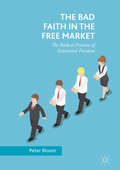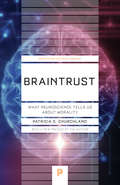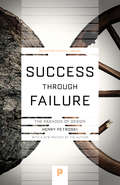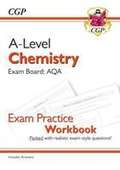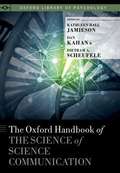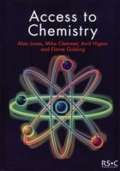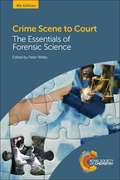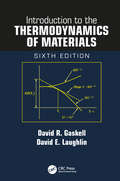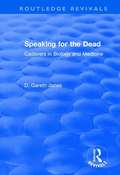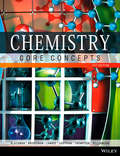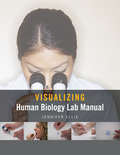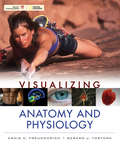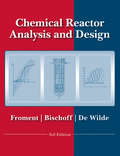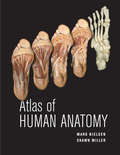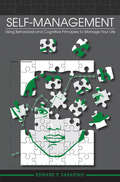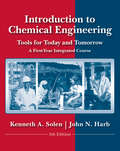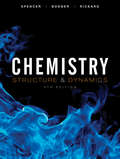- Table View
- List View
A Laboratory Manual in Biophotonics
by Vadim Backman Adam Wax Hao F. ZhangBiophotonics is a burgeoning field that has afforded researchers and medical practitioners alike an invaluable tool for implementing optical microscopy. Recent advances in research have enabled scientists to measure and visualize the structural composition of cells and tissue while generating applications that aid in the detection of diseases such as cancer, Alzheimer’s, and atherosclerosis. Rather than divulge a perfunctory glance into the field of biophotonics, this textbook aims to fully immerse senior undergraduates, graduates, and research professionals in the fundamental knowledge necessary for acquiring a more advanced awareness of concepts and pushing the field beyond its current boundaries. The authors furnish readers with a pragmatic, quantitative, and systematic view of biophotonics, engaging such topics as light-tissue interaction, the use of optical instrumentation, and formulating new methods for performing analysis. Designed for use in classroom lectures, seminars, or professional laboratories, the inclusion and incorporation of this textbook can greatly benefit readers as it serves as a comprehensive introduction to current optical techniques used in biomedical applications. Caters to the needs of graduate and undergraduate students as well as R&D professionals engaged in biophotonics research. Guides readers in the field of biophotonics, beginning with basic concepts before proceeding to more advanced topics and applications. Serves as a primary text for attaining an in-depth, systematic view of principles and applications related to biophotonics. Presents a quantitative overview of the fundamentals of biophotonic technologies. Equips readers to apply fundamentals to practical aspects of biophotonics.
Climate Politics and the Impact of Think Tanks: Scientific Expertise in Germany and the US
by Alexander RuserThis book provides an innovative theoretical and analytical framework for studying the role and impact of specialized research organizations and consultancies on decision making in climate politics. It includes advanced empirical analysis of the case of Germany, compared with the situation in the USA. The book improves the understanding of the role and impact of ‘scientific’ advice in coping with the challenge of anthropogenic climate change.
Climate Politics and the Impact of Think Tanks: Scientific Expertise in Germany and the US
by Alexander RuserThis book provides an innovative theoretical and analytical framework for studying the role and impact of specialized research organizations and consultancies on decision making in climate politics. It includes advanced empirical analysis of the case of Germany, compared with the situation in the USA. The book improves the understanding of the role and impact of ‘scientific’ advice in coping with the challenge of anthropogenic climate change.
Key Stage 3 Science: Spectrum Year 7 Class Book (PDF)
by Andy Cooke Jean MartinScience resources to support the pre-2008 Key Stage 3 QCA Scheme of Work. Year 7 is an engaging Class Book that meet the needs of both teachers and pupils for the pre-2008 Science Strategy and Framework for Key Stage 3. The differentiated questions build thinking skills and Scientific Enquiry is integrated throughout.
Introduction to Interactive Boundary Layer Theory (PDF)
by Ian J. SobeyOne of the major achievements in fluid mechanics in the last quarter of the twentieth century has been the development of an asymptotic description of perturbations to boundary layers known generally as 'triple deck theory'. These developments have had a major impact on our understanding of laminar fluid flow, particularly laminar separation. It is also true that the theory rests on three quarters of a century of development of boundary layer theory which involves analysis, experimentation and computation. All these parts go together, and to understand the triple deck it is necessary to understand which problems the triple deck resolves and which computational techniques have been applied. This book presents a unified account of the development of laminar boundary layer theory as a historical study together with a description of the application of the ideas of triple deck theory to flow past a plate, to separation from a cylinder and to flow in channels. The book is intended to provide a graduate level teaching resource as well as a mathematically oriented account for a general reader in applied mathematics, engineering, physics or scientific computation.
The Bad Faith in the Free Market: The Radical Promise of Existential Freedom
by Peter BloomInnovatively combining existentialist philosophy with cutting edge post-structuralist and psychoanalytic perspectives, this book boldly reconsiders market freedom. Bloom argues that present day capitalism has robbed us of our individual and collective ability to imagine and implement alternative and more progressive economic and social systems; it has deprived us of our radical freedom to choose how we live and what we can become.Since the Great Recession, capitalism has been increasingly blamed for rising inequality and feelings of mass social and political alienation. In place of a deeper liberty, the free market offers subjects the opportunity to continually reinvest their personal and shared hopes within its dogmatic ideology and policies. This embrace helps to temporarily alleviate growing feelings of anxiety and insecurity at the expense of our fundamental human agency. What has become abundantly clear is that the free market is anything but free.Here, Bloom exposes our present day bad faith in the free market and how we can break free from it.
The Bad Faith in the Free Market: The Radical Promise of Existential Freedom
by Peter BloomInnovatively combining existentialist philosophy with cutting edge post-structuralist and psychoanalytic perspectives, this book boldly reconsiders market freedom. Bloom argues that present day capitalism has robbed us of our individual and collective ability to imagine and implement alternative and more progressive economic and social systems; it has deprived us of our radical freedom to choose how we live and what we can become.Since the Great Recession, capitalism has been increasingly blamed for rising inequality and feelings of mass social and political alienation. In place of a deeper liberty, the free market offers subjects the opportunity to continually reinvest their personal and shared hopes within its dogmatic ideology and policies. This embrace helps to temporarily alleviate growing feelings of anxiety and insecurity at the expense of our fundamental human agency. What has become abundantly clear is that the free market is anything but free.Here, Bloom exposes our present day bad faith in the free market and how we can break free from it.
Braintrust: What Neuroscience Tells Us about Morality (Princeton Science Library (PDF))
by Patricia S. ChurchlandWhat is morality? Where does it come from? And why do most of us heed its call most of the time? In Braintrust, neurophilosophy pioneer Patricia Churchland argues that morality originates in the biology of the brain. She describes the "neurobiological platform of bonding" that, modified by evolutionary pressures and cultural values, has led to human styles of moral behavior. The result is a provocative genealogy of morals that asks us to reevaluate the priority given to religion, absolute rules, and pure reason in accounting for the basis of morality. Moral values, Churchland argues, are rooted in a behavior common to all mammals--the caring for offspring. The evolved structure, processes, and chemistry of the brain incline humans to strive not only for self-preservation but for the well-being of allied selves--first offspring, then mates, kin, and so on, in wider and wider "caring" circles. Separation and exclusion cause pain, and the company of loved ones causes pleasure; responding to feelings of social pain and pleasure, brains adjust their circuitry to local customs. In this way, caring is apportioned, conscience molded, and moral intuitions instilled. A key part of the story is oxytocin, an ancient body-and-brain molecule that, by decreasing the stress response, allows humans to develop the trust in one another necessary for the development of close-knit ties, social institutions, and morality. A major new account of what really makes us moral, Braintrust challenges us to reconsider the origins of some of our most cherished values.
Braintrust: What Neuroscience Tells Us about Morality (Princeton Science Library (PDF))
by Patricia S. ChurchlandWhat is morality? Where does it come from? And why do most of us heed its call most of the time? In Braintrust, neurophilosophy pioneer Patricia Churchland argues that morality originates in the biology of the brain. She describes the "neurobiological platform of bonding" that, modified by evolutionary pressures and cultural values, has led to human styles of moral behavior. The result is a provocative genealogy of morals that asks us to reevaluate the priority given to religion, absolute rules, and pure reason in accounting for the basis of morality. Moral values, Churchland argues, are rooted in a behavior common to all mammals--the caring for offspring. The evolved structure, processes, and chemistry of the brain incline humans to strive not only for self-preservation but for the well-being of allied selves--first offspring, then mates, kin, and so on, in wider and wider "caring" circles. Separation and exclusion cause pain, and the company of loved ones causes pleasure; responding to feelings of social pain and pleasure, brains adjust their circuitry to local customs. In this way, caring is apportioned, conscience molded, and moral intuitions instilled. A key part of the story is oxytocin, an ancient body-and-brain molecule that, by decreasing the stress response, allows humans to develop the trust in one another necessary for the development of close-knit ties, social institutions, and morality. A major new account of what really makes us moral, Braintrust challenges us to reconsider the origins of some of our most cherished values.
Success through Failure: The Paradox of Design (Princeton Science Library (PDF))
by Henry PetroskiDesign pervades our lives. Everything from drafting a PowerPoint presentation to planning a state-of-the-art bridge embodies this universal human activity. But what makes a great design? In this compelling and wide-ranging look at the essence of invention, distinguished engineer and author Henry Petroski argues that, time and again, we have built success on the back of failure--not through easy imitation of success. Success through Failure shows us that making something better--by carefully anticipating and thus averting failure--is what invention and design are all about. Petroski explores the nature of invention and the character of the inventor through an unprecedented range of both everyday and extraordinary examples--illustrated lectures, child-resistant packaging for drugs, national constitutions, medical devices, the world's tallest skyscrapers, long-span bridges, and more. Stressing throughout that there is no surer road to eventual failure than modeling designs solely on past successes, he sheds new light on spectacular failures, from the destruction of the Tacoma Narrows Bridge in 1940 and the space shuttle disasters of recent decades, to the collapse of the World Trade Center in 2001. Petroski also looks at the prehistoric and ancient roots of many modern designs. The historical record, especially as embodied in failures, reveals patterns of human social behavior that have implications for large structures like bridges and vast organizations like NASA. Success through Failure--which will fascinate anyone intrigued by design, including engineers, architects, and designers themselves--concludes by speculating on when we can expect the next major bridge failure to occur, and the kind of bridge most likely to be involved.
Success through Failure: The Paradox of Design (Princeton Science Library (PDF))
by Henry PetroskiDesign pervades our lives. Everything from drafting a PowerPoint presentation to planning a state-of-the-art bridge embodies this universal human activity. But what makes a great design? In this compelling and wide-ranging look at the essence of invention, distinguished engineer and author Henry Petroski argues that, time and again, we have built success on the back of failure--not through easy imitation of success. Success through Failure shows us that making something better--by carefully anticipating and thus averting failure--is what invention and design are all about. Petroski explores the nature of invention and the character of the inventor through an unprecedented range of both everyday and extraordinary examples--illustrated lectures, child-resistant packaging for drugs, national constitutions, medical devices, the world's tallest skyscrapers, long-span bridges, and more. Stressing throughout that there is no surer road to eventual failure than modeling designs solely on past successes, he sheds new light on spectacular failures, from the destruction of the Tacoma Narrows Bridge in 1940 and the space shuttle disasters of recent decades, to the collapse of the World Trade Center in 2001. Petroski also looks at the prehistoric and ancient roots of many modern designs. The historical record, especially as embodied in failures, reveals patterns of human social behavior that have implications for large structures like bridges and vast organizations like NASA. Success through Failure--which will fascinate anyone intrigued by design, including engineers, architects, and designers themselves--concludes by speculating on when we can expect the next major bridge failure to occur, and the kind of bridge most likely to be involved.
New A-Level Chemistry for 2018: AQA Year 1 & 2 Exam Practice Workbook - includes Answers (PDF)
by Cgp Books"Bursting with exam-style questions this superb CGP Exam Practice Workbook is the perfect companion for Year 1 & 2 of AQA A-Level Chemistry. It’s packed with questions covering every topic students need to know, including a section of mixed (synoptic) questions. We’ve also added in exam tips throughout to make sure there are no unpleasant surprises in their exams! To round things off there are fully worked answers and mark schemes for every question. For study notes and even more practice don’t miss the CGP AQA A-Level Chemistry Complete Revision & Practice guide (9781782943006). "
The Oxford Handbook Of The Science Of Science Communication (PDF)
by Kathleen Hall Jamieson Dan Kahan Dietram A. ScheufeleDrawing on the expertise of leading science communication scholars from six countries, The Oxford Handbook of the Science of Science Communication not only charts the media landscape - from news and entertainment to blogs and films - but also examines the powers and perils of human biases - from the disposition to seek confirming evidence to the inclination to overweight endpoints in a trend line. In the process, it draws together the best available social science on ways to communicate science while also minimizing the pernicious effects of human bias.
Access To Chemistry (PDF)
by Alan Jones Elaine Golding Mike Clemmet Avril HigtonThis book effectively forms a self-study course, which is split into separate modules and units covering all concepts required for those needing a basic knowledge of chemistry.
Crime Scene To Court (PDF)
by Peter C. White David Halliday Sharon Broome Mark Mastaglio Blaine Price Michael Cole Hazel Torrance Nigel Watson Tal Simmons Ann Priston Karl C. Harrison Joanne Millington Caroline O'Mahoney Clive Reedman Angela Shaw Cliff Todd John Tuer Brian Rankin Mark Baron Patricia Wiltshire Dorothy Gennard Tiernan Coyle David Baldwin Audrey GilesThe fascinating field of forensic science can be challenging to understand. Written for non-scientists, or those with limited scientific knowledge, this book covers the three main areas of an investigation where forensic science is practiced: at the scene of the crime, in the forensic laboratory and at court. The fourth edition of this popular book features a new chapter on identifying an individual, including bio-metrics and a new chapter covering digital crime. The book has been updated throughout, keeping readers at the forefront of current practices across the forensic disciplines. Ideal for anyone studying forensic science or law, this book details how crime scene and forensic examinations are conducted in the United Kingdom, courtroom procedures and the role of the expert witness. It is an excellent source of information for anyone with a role in an investigation, including the police and crime scene investigators.
Introduction to the Thermodynamics of Materials, Sixth Edition
by David R. Gaskell David E. LaughlinMaintaining the substance that made Introduction to the Thermodynamic of Materials a perennial best seller for decades, this Sixth Edition is updated to reflect the broadening field of materials science and engineering. The new edition is reorganized into three major sections to align the book for practical coursework, with the first (Thermodynamic Principles) and second (Phase Equilibria) sections aimed at use in a one semester undergraduate course. The third section (Reactions and Transformations) can be used in other courses of the curriculum that deal with oxidation, energy, and phase transformations. The book is updated to include the role of work terms other than PV work (e.g., magnetic work) along with their attendant aspects of entropy, Maxwell equations, and the role of such applied fields on phase diagrams. There is also an increased emphasis on the thermodynamics of phase transformations and the Sixth Edition features an entirely new chapter 15 that links specific thermodynamic applications to the study of phase transformations. The book also features more than 50 new end of chapter problems and more than 50 new figures.
Speaking For The Dead: Cadavers In Biology And Medicine (Routledge Revivals Series (PDF))
by D. Gareth JonesThis was first published in 2000: This text explores issues surrounding the use of human cadavers and human tissues in science and medicine. This is an area of increasing significance in contemporary society, as more and more techniques become available for manipulating human genes and human material (including embryos, body organs and brain tissue). These issues are explored through case studies from contemporary society. Some of the most topical issues examined include plastination of human bodies as an art form, the use of biopsies from surgical operations, the ethics of using human DNA and stem cells in research, and the debate surrounding the transplantation of animal tissue and organs into humans.
Chemistry: Core Concepts
by Allan Blackman Adam Bridgeman Gwendolyn Lawrie Daniel Southam Christopher Thompson Natalie WilliamsonChemistry: Core Concepts continues the substantial commitment of Wiley to chemistry education in Australia and New Zealand. The text has been developed by a group of leading chemistry educators for students entering university with little or no background in chemistry. It presents the core concepts in chemistry at a level that will enable students to build confidence and achieve success in their university chemistry studies in discipline areas such as the applied sciences, health sciences and engineering. All the fundamentals are covered - including the use of chemistry language, symbols and molecular structures - and it also develops the requisite quantitative skills. Chemistry: Core Concepts has been adapted from Wiley's market leading Chemistry text by Blackman, Bottle, Schmid, Mocerino and Wille. Many of the strengths of this book have been retained, however the narrative has been abridged and simplified to make it more accessible for foundation students. A hallmark feature of the core text is the "stepped" demonstration problems, which model a consistent problem-solving methodology designed to encourage students to break complex tasks down into their constituent parts. Another key pedagogical element of the text is the "Chemical Connections" feature, which brings additional meaning to the study of chemistry by highlighting the connections between the chemical concepts within the chapter and local applications of that chemistry in the world around us. Importantly, Chemistry: Core Concepts was envisaged as a print/digital product, where the narrative in the text is designed to be rendered as an interactive journey through a media-enhanced E-Text, providing students with the opportunity to view chemical reactions as movies, demonstration problems as animations and end-of-chapter questions are presented as online revision quizzes that provide instant feedback and progress reports. The digital version of the text will be delivered in the ground-breaking WileyPLUS Learning Space framework, an exciting new teaching and learning environment that provides a personalised learning experience for students and transforms courses into a vibrant, collaborative learning community.
Visualizing Human Biology Lab Manual
by Jennifer EllieVisualizing Human Biology Lab Manual provides 18 labs specifically designed for the non-majors biology student, each of which engages students by focusing on the structure and function of each persons own unique body. The lab manual includes key experiments with step-by-step visual guides and more interesting, real world topics to connect with students diverse experiences. Visuals are used to teach and explain, not just illustrate, and students with varied learning styles will be engaged. The applications of common laboratory techniques in science, medicine, and everyday life are also explored in each lab topic.
Visualizing Anatomy and Physiology
by Craig Freudenrich Gerard J. TortoraVisualizing Anatomy and Physiology is a visually powerful textbook, illustrated for maximum pedagogical effect, up-to-the-minute in all aspects of anatomical science and physiology, that provides motivating and engaging content as well as clinical and everyday relevance of the science of the discipline.
Chemical Reactor Analysis and Design
by Gilbert F. Froment Kenneth B. Bischoff Juray De WildeThis is the Third Edition of the standard text on chemical reaction engineering, beginning with basic definitions and fundamental principles and continuing all the way to practical applications, emphasizing real-world aspects of industrial practice. The text includes updated coverage of computer modeling methods and many new worked examples. Most of the examples use real kinetic data from processes of industrial importance.
Atlas of Human Anatomy
by Mark Nielsen Shawn D. MillerThis new manual takes a systemic approach with each chapter focusing on one body system. The order of chapters follows the traditional order found in anatomy or anatomy and physiology courses. The photos include skeletal images, photomicrographs of histology and cadaver dissections. This atlas includes full-color photographs of actual cadaver dissections instead of idealized illustrations, to accurately and realistically represent anatomical structures.
Self-Management: Using Behavioral and Cognitive Principles to Manage Your Life
by Edward P. SarafinoSelf-Management, First Edition gives instructors flexibility in teaching self management skills & behavior changes. With this book, students can discuss the design of hypothetical self-management projects in class or design and carry out an actual project to change their own behaviors. More importantly, it will enable students to teach these skills to others, particularly clients in their future careers. A main feature of this text is the inclusion of application exercises. These exercises can serve two functions. First, they enable students to draw together their answers and solutions in the work sheets provided to form the basis for a program design. Second, the exercises get the students actively involved in the chapter material, promoting a more detailed and full understanding of the concepts and techniques.
Introduction to Chemical Engineering: Tools for Today and Tomorrow
by Kenneth A. Solen John N. HarbThis concise book is a broad and highly motivational introduction for first-year engineering students to the exciting of field of chemical engineering. The material in the text is meant to precede the traditional second-year topics. It provides students with, 1) materials to assist them in deciding whether to major in chemical engineering; and 2) help for future chemical engineering majors to recognize in later courses the connections between advanced topics and relationships to the whole discipline. This text, or portions of it, may be useful for the chemical engineering portion of a broader freshman level introduction to engineering course that examines multiple engineering fields.
Chemistry: Structure and Dynamics
by James N. Spencer George M. Bodner Lyman H. RickardSpencer's Chemistry: Structure and Dynamics is the most successful reform project published for the General Chemistry course. The authors have built the text on the recommendations of the ACS's Task Force on the General Chemistry Curriculum and suggestions from the adopters of previous editions. This innovative text provides a sixteen-chapter introduction to the fundamental concepts of chemistry. The material is supplemented by special topics at the end of each chapter. There are three major themes that link the content of the book: the process of science, the relationship between molecular structure and physical/chemical properties, and the relationship between the microscopic and macroscopic levels. Spencer's Chemistry can work successfully in both small and large lecture courses.
